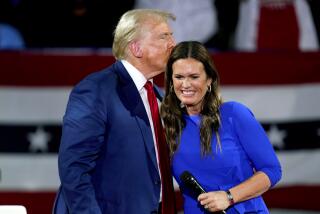A hollow defense of DOMA
- Share via
Next spring, when the U.S. Supreme Court hears oral arguments in United States vs. Windsor, a case challenging the Defense of Marriage Act, one argument likely to be made by DOMA’s supporters is that of “responsible procreation.”
The theory, which has been embraced by some courts and rejected by others, holds that federal marriage benefits are offered because the government has an interest in promoting stable families in which children are raised by their two biological parents. Because gay couples can’t have children who are biologically related to both parents, the reasoning goes, they shouldn’t receive any of these federal marital benefits.
Because of DOMA, same-sex couples are not eligible for more than 1,000 federal marital rights. They cannot sponsor a non-citizen spouse to immigrate. They cannot file joint federal tax returns, and they are not entitled to family or medical leave to care for an ailing spouse. And, in the event of a spouse’s death, they cannot collect spousal Social Security benefits and are not exempt from federal inheritance taxes.
TIMELINE: Gay marriage chronology
This year, in the Windsor case that will be decided by the Supreme Court, the U.S. 2nd Circuit Court of Appeals found DOMA unconstitutional. But the three-judge panel that heard the case was divided.
In his dissent to the majority opinion, Judge Chester Straub cited responsible procreation as a reason DOMA should be upheld. Congress and the president, he wrote, had legitimately decided to grant heterosexual marriage certain privileges because it is the only kind of relationship “inherently capable of producing another generation of humanity.” He went on to note that DOMA reflected a “congressional desire to have children raised in families with only biological mothers and fathers.”
But is that reasoning valid? For one thing, federal marriage benefits are extended to couples who marry late in life and are thus unable to procreate. Also, the federal government has long provided protections to families with dependent children, even when those children were not biologically related to the people caring for them. This inclusive policy is reflected in two of the largest and most important federal benefits programs: Social Security and benefits for members of the U.S. military.
From the inception of children’s Social Security benefits in 1939, Congress explicitly and deliberately included both adopted children and stepchildren — two groups of children that are biologically unrelated to at least one of their parents — as potential beneficiaries. Congress recognized that many adopted children and stepchildren were dependent on their parents (biological or not) and that such children would be left vulnerable if their parents (biological or not) died or became disabled.
Similar goals focusing on dependency rather than biology are also evident in programs that protect the family members of persons serving in the U.S. armed forces. For nearly a century, military benefits programs have explicitly covered children who are not biologically related to their parent service member. For example, the 1917 War Risk Insurance Act permitted enlisted men to designate certain family members to receive insurance proceeds in the event of their death or disability. Like the Social Security Act, this law expressly included adopted children and stepchildren as eligible family members.
The history of federal military benefits demonstrates not only that Congress intentionally included families with non-biological children but also that this inclusion was important to Congress. For example, after the comptroller of the Treasury concluded in 1918 that a certain military benefits statute did not include stepchildren, Congress stepped in and clarified that the term “children” in this and a range of other military benefits provisions included both adopted children and stepchildren.
In its report, Congress explained that the comptroller’s narrow interpretation of the word “children” constituted “discrimination and hardship to the parents concerned” and was inconsistent with the basic purpose of these benefits, which was to protect those people who were dependent on the service member.
In the end, responsible procreation is based on myth, not on history and tradition. The U.S. Supreme Court now has an opportunity to call out the argument for what it is: an attempt to single out lesbian and gay couples for different and discriminatory treatment simply because of their sexual orientation.
Courtney G. Joslin is a professor of law at UC Davis School of Law. She is coauthor of the book “Lesbian, Gay, Bisexual, and Transgender Family Law.”
More to Read
A cure for the common opinion
Get thought-provoking perspectives with our weekly newsletter.
You may occasionally receive promotional content from the Los Angeles Times.









